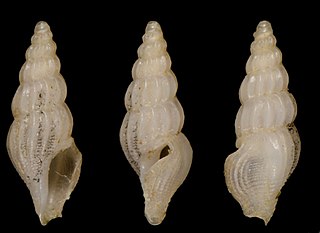
Enoploteuthidae is a family of squid comprising approximately 40 species in four genera. Most species have a mantle length ranging from 3–13 cm (1.2–5.1 in). Hooks are present on all arms and tentacles. The family is best known for the large array of photophores throughout the body.

Conchology is the study of mollusc shells. Conchology is one aspect of malacology, the study of molluscs; however, malacology is the study of molluscs as whole organisms, whereas conchology is confined to the study of their shells. It includes the study of land and freshwater mollusc shells as well as seashells and extends to the study of a gastropod's operculum.

Siren is a genus of aquatic salamanders of the family Sirenidae. The genus consists of five living species, along with one extinct species from the Eocene Epoch and three from the Miocene.

Enoploteuthis is a genus of squid in the family Enoploteuthidae. The species of Enoploteuthis are most easily recognised by having a larger tail when compared to the other genera in the Enoploteuthidae. The tail's size is emphasised by not having the fins extending along its sides. In related genera there is a narrow extension of the fins along the tail. Other characteristics include the presence of suckers on the distal portion of arms IV where there at no photophores present; the tentacular club has two rows of hooks and no marginal suckers; on the buccal crown there are typical chromatophores on the aboral surface but on the oral surface there may be some light skin pigmentation. They have 9-10 photophores on the eye and they have complex photophores in the skin. In the females the Spermatangia receptacles are at the posterior junction of muscles used to retract the funnel and the muscles which retract the head. Enoploteuthis differs from other genera of the Enoploteuthidae in having two rather than three types of photophores in its integument and these are on the ventral areas of the head, funnel and mantle. All species of Enoploteuthis which have been studied have the most complex type of photophoreand seems to be a distinctive characteristic of this genus. Enoploteuthis contains the largest species in the family, attaining a mantle length of 130mm.

Cochliopidae is a family of small freshwater snails with gills and an operculum, aquatic gastropod mollusks.

Syntomodrillia carolinae is a species of sea snail, a marine gastropod mollusk in the family Drilliidae.
Syntomodrillia woodringi is a species of sea snail, a marine gastropod mollusk in the family Drilliidae. The species is named in honor of Wendell P. Woodring.
Turbonilla reticulata is a species of sea snail, a marine gastropod mollusk in the family Pyramidellidae, the pyrams and their allies.

Zeidora reticulata is a species of sea snail, a marine gastropod mollusk in the family Fissurellidae, the keyhole limpets and slit limpets.

Tellinoidea is a taxonomic superfamily of saltwater clams, marine bivalve molluscs in the order Cardiida.

Conus is a genus of venomous and predatory sea snails, or cone snails, marine gastropod mollusks in the family Conidae. Prior to 2009, it included all cone snail species but is now more precisely defined, as are other cone snail genera.
Enoploteuthis semilineata is a species of squid within the family Enoploteuthidae known to inhabit the central South Pacific in deep-water environments. It is currently listed as 'Data deficient' by the IUCN Red List in 2010 due to little information on the species.
Enoploteuthis jonesi is a species of squid from the family Enoploteuthidae. The species is gonochoric and can be found in the Pacific Ocean.
Enoploteuthis higginsi is a species of squid from the family Enoploteuthidae. The species is gonochoric, and can be found in the Eastern Pacific Ocean.
Enoploteuthis galaxias is a species of squid from the family Enoploteuthidae. The species has been observed off the coast of Tasmania.
Enoploteuthis octolineata is a species of squid from the family Enoploteuthidae. The species has been observed off the coast of Kiribati in the South Pacific Ocean.
Enoploteuthis magnoceani is a subspecies^ of Enoploteuthis leptura from the family Enoploteuthidae. Some authorities consider Enoploteuthis magnoceani as being its own species, and has been observed in the Indo-Pacific Ocean.
Enoploteuthis obliqua is a species of squid from the family Enoploteuthidae. The species is rarely documented, but has been observed in the North Pacific Ocean.
Enoploteuthis chunii is a species of squid from the family Enoploteuthidae. They have been observed off the coast of Korea.
Enoploteuthis anapsis, also known as the starlit enope squid, is a species of squid from the family Enoploteuthidae. The species is gonochoric, and can be found in the Atlantic Ocean.








